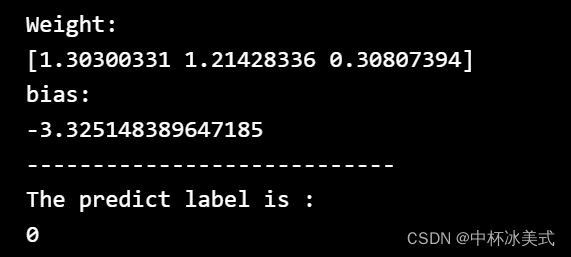1. 最大熵模型
作用是从许多个模型中,选择一个最好的模型,选择的标准就是熵,即具有最大熵的 P ( Y ∣ X ) P(Y|X) P(Y∣X)就是最好的模型。个人理解最大熵在这里起的作用类似于valid data 的作用。为什么最大熵的模型就是最好的呢?因为在自然界中,所有的分布都是趋于无序的、混乱的。最大熵准则则保留了每一种可能发生的情况,可以代表更多的可能发生的信息。比如你在猜抛掷一枚硬币,正面朝上的概率的时候,最好猜1/2而不是3/10.
2.Logistic回归
适用于多分类,二分类任务。注意:只适用于线性可分的任务,对于非线性的分类任务,logistic不能求解,此时可以适用svm等其它算法求解。分布函数是一个S形函数,记原始的训练集为 { ( x 1 , y 1 ) , ( x 2 , y 2 ) , ( x 3 , y 3 ) , . . . , ( x m , y m ) } \{(x_1,y_1), (x_2,y_2), (x_3,y_3), ..., (x_m,y_m) \} {(x1,y1),(x2,y2),(x3,y3),...,(xm,ym)}, x i ∈ R n x_i\in \mathbb{R}^n xi∈Rn, y i ∈ { 1 , 2 , . . . , K } y_i\in \{1,2, ..., K\} yi∈{1,2,...,K}。通过s函数,将 w T x + b w^T x +b wTx+b 的值域从 ( − ∞ , + ∞ ) (-\infty,+\infty) (−∞,+∞)映射为(0,1)。
3.代码实现
使用梯度下降法更新参数w,b
import numpy as np
import matplotlib.pyplot as plt
class LogisticClassifier:
def __init__(self,learning_rate,epoch,delta):
self.lr_rate = learning_rate
self.epochs = epoch
self.delta = delta
self.w = None
def sigmoid(self,x):
return 1/(1+np.exp(-x))
def fit(self,X_train,y_train):
decent = 0
y_train = y_train.T
#print(y_train.shape)
self.w = np.zeros(X_train.shape[1]).reshape(1,-1) # 根据训练数据特征值的维数初始化参数w的维度以及形状
for i in range(self.epochs):
## 计算W.T 点乘 x
#print(i)
z = np.dot(X_train,self.w.T) # M*N (1*N).T
h_theta = self.sigmoid(z)
#print(h_theta.shape)
error = h_theta - y_train # y是一个列向量,计算误差
error_ = X_train*error
# 计算梯度
decent = error_.sum(axis=0) ## 这个是梯度,并不是指的loss
if (np.abs(decent) <= self.delta).all():
break
else:
self.w = self.w -self.lr_rate*decent
print('Weight: ')
print(self.w[0][:-1])
print('bias:')
print(self.w[0][-1])
def predict(self,X_test):
X_test = np.append(X_test,np.ones((X_test.shape[0],1)),axis=1)
predic = self.sigmoid(np.dot(X_test,self.w.T))
result = np.asarray((predic >= 0.5).astype(int))
print('----------------------------')
print('The predict label is :')
print(result[0][0])
if __name__ == '__main__':
x1 = [3,3,3,1]
x2 = [4,3,2,1]
x3 = [2,1,2,1]
x4 = [1,1,1,0]
x5 = [-1,0,1,0]
x6 = [2,-2,1,0]
data = np.array([x1,x2,x3,x4,x5,x6]).reshape(6,-1)
x_image = data[:,:-1] # 获得训练集中的特征值
m,n = np.shape(x_image) # 获得feature的维度,m是样本个数,n是特征的维度
x_image = np.append(x_image,np.ones((m,1)),axis = 1) # w.dot x + b 统一看作一个大的矩阵,用矩阵相乘表示这个运算过程。
x_label = data[:,-1].reshape(1,-1) # 获得训练集数据的标签值
classifier = LogisticClassifier(learning_rate=0.1,epoch=100,delta=0.02)
classifier.fit(x_image,x_label)
X_test = np.array([1,2,-2]).reshape(1,-1)
classifier.predict(X_test)
运行结果:






















 1万+
1万+











 被折叠的 条评论
为什么被折叠?
被折叠的 条评论
为什么被折叠?








